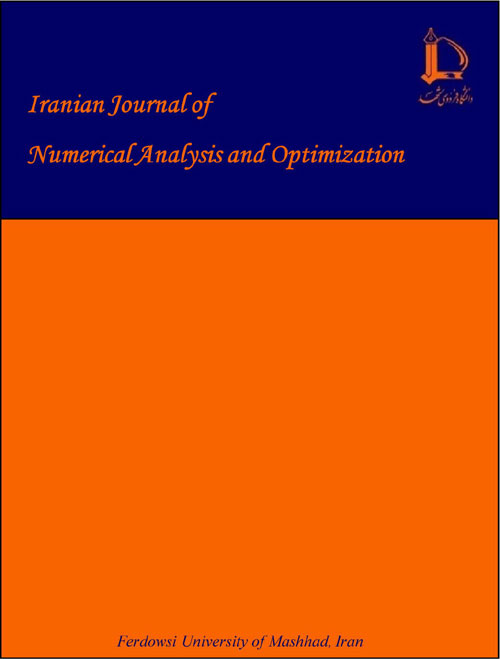فهرست مطالب

Iranian Journal of Numerical Analysis and Optimization
Volume:5 Issue: 1, Winter and Spring 2015
- تاریخ انتشار: 1394/02/03
- تعداد عناوین: 6
-
-
Pages 1-12In this paper, a class of semi-implicit two-stage stochastic Runge-Kutta methods (SRKs) of strong global order one, with minimum principal error constants are given. These methods are applied to solve Itô stochastic differential equations (SDEs) with a Wiener process. The efficiency of this method with respect to explicit two-stage Itô Runge-Kutta methods (IRKs), It method, Milstien method, semi-implicit and implicit two-stage Stratonovich Runge-Kutta methods are demonstrated by presenting some numerical results.Keywords: Stochastic differential equations, Strong approximation, Runge, Kutta methods
-
Pages 13-36In this paper, a two-phase algorithm, namely IVNS, is proposed for solving nonlinear optimal control problems. In each phase of the algorithm, we use a variable neighborhood search (VNS), which performs a uniform distribution in the shaking step and the successive quadratic programming, as the local search step. In the first phase, VNS starts with a completely random initial solution of control input values. To increase the accuracy of the solution obtained from the phase 1, some new time nodes are added and the values of the new control inputs are estimated by spline interpolation. Next, in the second phase, VNS restarts by the solution constructed by the phase 1. The proposed algorithm is implemented on more than 20 well-known benchmarks and real world problems, then the results are compared with some recently proposed algorithms. The numerical results show that IVNS can find the best solution on 84% of test problems. Also, to compare the IVNS with a common VNS (when the number of time nodes is same in both phases), a computational study is done. This study shows that IVNS needs less computational time with respect to common VNS, when the quality of solutions are not different signifcantly.Keywords: Nonlinear optimal control problem, Variable neighborhood search, Successive quadratic programming
-
Pages 37-48In this paper, the sinc collocation method is proposed for solving linear and nonlinear multi-order fractional differential equations based on the new definition of fractional derivative which is recently presented by Khalil, R., Al Horani, M., Yousef, A. and Sababeh, M. in A new definition of fractional derivative, J. Comput. Appl. Math. 264 (2014), 65{70. The properties of sinc functions are used to reduce the fractional differential equation to a system of algebraic equations. Several numerical examples are provided to illustrate the accuracy and effectiveness of the presented method.Keywords: Sinc function, Fractional differential equations, Multi, order FDEs, Collocation method
-
Pages 49-61We introduce a RBFs mesheless method of lines that decomposes the interior and boundary centers to obtain the numerical solution of the time dependent PDEs. Then, the method is applied with an adaptive algorithm to obtain the numerical solution of one dimensional problem. We show that in the problems in which the solutions contain region with rapid variation, the adaptive RBFs methods are successful so that the PDE solution can be approximated well with a small number of basis functions. The method is described in detail, and computational experiments are performed for one-dimensional Burgers'' equations.Keywords: Method of Lines, Radial basis functions, Adaptive Method, Burger's Equations
-
Pages 63-72In this article, a numerical approximation to the solution of the Newell-Whitehead equation (NWE) and Cauchy problem of ill-posed non-linear diffusion equation have been studied. The presented scheme is obtained by using the derivative of the cubic B-spline quasi-interpolation (BSQI) to approximate the spatial derivative of the dependent variable and first order forward difference to approximate the time derivative of the dependent variable. Some numerical experiments are provided to illustrate the method. The results of numerical experiments are compared with analytical solutions. The main advantage of the scheme is that the algorithm is very simple and very easy to implement.Keywords: B, spline quasi, interpolation, convection, diffusion equation, difference schemes
-
Pages 73-83We present here the numerical solution of damped forced oscillator problem using Haar wavelet and compare the numerical results obtained with some well-known numerical methods such as Runge-Kutta fourth order classical and Taylor Series methods. Numerical results show that the present Haar wavelet method gives more accurate approximations than above said numerical methods.Keywords: Haar wavelet method, Differential equation, Operational matrix, Damped forced oscillator

